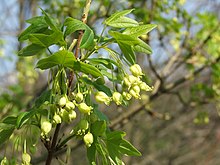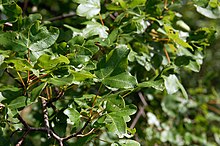|
Acer monspessulanum
Acer monspessulanum, the Montpellier maple, is a species of maple native to the Mediterranean region from Morocco and Portugal in the west, to Turkey, Syria, Lebanon, and Israel in the east, and north to the Jura Mountains in France and the Eifel in Germany.[3][4][5] DescriptionAcer monspessulanum is a medium-sized deciduous tree or densely branched shrub that grows to a height of 10 to 15 metres (33 to 49 ft) (rarely to 20 metres (66 ft)).[6] The trunk is up to 75 cm diameter, with smooth, dark grey bark on young trees, becoming finely fissured on old trees. Among similar maples is most easily distinguished by its small three-lobed leaves, 3–6 cm long and 3–7 cm wide, glossy dark green, sometimes a bit leathery, and with a smooth margin, with a 2–5 cm petiole. The leaves fall very late in autumn, typically in November. The flowers are produced in spring, in pendulous, yellow to white corymbs 2–3 cm long. The samaras are 2–3 cm long with rounded nutlets.[4][5]  SubspeciesIt is variable, and a number of subspecies and varieties have been described, but few are widely accepted as distinct. The most widely accepted as distinct is Acer monspessulanum subsp. microphyllum (Boiss.) Bornmueller, from Turkey and Lebanon, with smaller leaves not over 3 cm broad.[4] The species can be mistaken for Acer campestre (field maple), another maple native to Europe, from which it is best distinguished by the clear sap in the leaves (milk-white in field maple), and the much narrower angle between the samara wings.[4][5] CultivationAmong maples not endemic to Japan, A. monspessulanum (and the similar A. campestre) are popular among bonsai enthusiasts.[7] In both cases, the smallish leaves and shrubby habit of the maple respond well to techniques to encourage leaf reduction and ramification.[8] These bonsai have an appearance distinct from those created from maples such as Acer palmatum whose leaves are more frilly and translucent.[citation needed] Otherwise, Acer monspessulanum is rarely seen in cultivation outside of arboreta. In the United States, a mature specimen may be seen at Arnold Arboretum in Boston, Massachusetts. A specimen can also be found in the arboretum of the Montreal Botanical Gardens.[citation needed] References
External links
|
||||||||||||||||||||||||||||||||||||||||||||||


